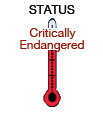ColorThe back and chest fins are black or dark grey, the sides slightly speckled with lighter grey and the abdominal is white or with light grey.
Average size150-185 cm/ about 60 kg for males and about 75 kg for females
Age8-12 years old
Record size & age190 cm, 79 kg and 23 years old
HabitatThe Harbor Porpoise inhabit shallow, coastal waters, usually in bays, estuaries, harbors, and large rivers. The preferred temperature is 15°C or less. They live in small groups of 2-8 individuals or alone. The size of the school is usually based on the food supply. Some animals migrate towards the North Sea in winter but most are believed to stay in the Baltic Sea.
FoodYoung Harbor Porpoise get milk from the mother for the first 9 months and then gradually moves towards a fish diet. As adults they eat fish up to 20-25 cm in size, which are swallowed whole. Fish in schools are easier for them to catch. Porpoises eat about 1-2 kg fish per day and the young need up to 7 kg of fish per day to survive. Porpoises usually hunt by themselves and use their eyes and echolocation to locate their pray.
ReproductionAge: 2-4 years old
Season: Summer
Number of pups: 1 every, or every other year
Porpoises mate promiscuously. Females are pregnant 10-11 months and can be pregnant and lactate at the same time. Young Harbor Porpoise stay close to the mother for about a year.
Human Impact and StatusThe main threats for Porpoises are static fishing techniques such as gill and tangle nets. Anchored to the sea floor and up to 20 km in length, different types of static net are used to target specific species of fish. Porpoises may not be able to detect these nets and get entangled, causing various types of wounds that they may die from, directly or indirectly.
Pollution and an increase in the water temperature are threats to the Harbor Porpoise, as well as to many other marine animals. Porpoises may not experience any toxic effects until they draw on their fat reserves, such as in periods of food shortage, during migration or reproduction. Overfishing may reduce preferred prey availability for Porpoises. Noise from boat traffic, oil platforms and the increasing number of wind-turbines greatly disturb the Harbor Porpoise since they use echolocation for communication and prey detection. Harbor porpoises are also affected by destruction of habitat due to coastal developments.
The Harbor Porpoise are protected and illegal to hunt. There are less than 600 individuals in the Baltic Sea subpopulation today. The numbers have decreased significantly and in the beginning of the 20th century, there were about 10 000 – 20 000 animals in the Baltic Sea.
CLOSE 
 English:
English: Svenska:
Svenska: Suomi:
Suomi: По-русски:
По-русски:  Esti:
Esti: Lietuviškai:
Lietuviškai: Latviešu:
Latviešu: Polski:
Polski: German:
German: Dansk:
Dansk:





